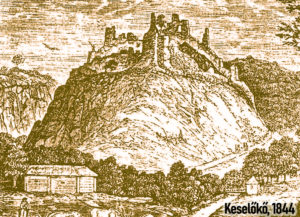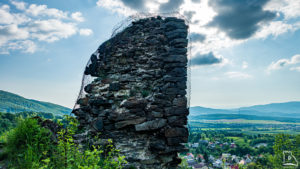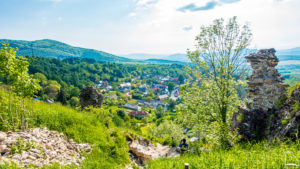Keselőkő

The little remains of Keselőkő Castle are found on a stark volcanic rocky hill on the edge of the village of Keselőkő (also known as Podhradie, Slovakia), approximately 18 km from Privigye, in the northwest section of the Madaras Mountains.

It’s named after the vultures that used to live there. The owner and date of construction are unknown, but it’s believed that Csák Máté owned or built it in the early 1300s. Historical records indicate that Bajmóc (‘castrum Boymuch’) nearby, was also given to Csák Máté, the lord of Trencsén by King Vencel in 1302.

The first mention of Keselőkő was found in a document from the Chapter of Nyitra, dated 4 April 1352. The document referred to castellan Gilétfi János as “magistro Johanne filio Gyleti castellano de Boymoch et de Keseleukeu”. In 1363, he remained the castellan of “Baymoch” and “Keseleukw” and also the Comes of Fejér and Tolna Counties. Keselőkő was a royal castle under the castle of Bajmóc, with identical castellans. In 1375, László, the son of Pósa, took over as castellan.

On 15th January 1388, King Zsigmond of Luxemburg gifted Keselőkő Castle to Kakas László, son of Pásztói János, and János, son of Domokos, in recognition of their services to King Louis, Queen Elizabeth, and Queen Mary.

On 20th March 1390, King Zsigmond confirmed that Leusták [Jolsvai/Ilsvai], the royal court master, and master Kakas László, son of Pásztói János, and János, son of Domokos had exchanged their estates. Leusták transferred the Litva castle, with its appurtenances and “Besenew” (Besenyő) estate, to the Pásztó family in exchange for the Keselőkő castle. Unfortunately, Jolsvai Leusták was captured by the Turks during the Battle of Nikápoly and died there.

According to a charter from 1420, Putnok László and István served as castellans of Kemenetz (also known as Keselőkő). On 5th December 1427, King Zsigmond commanded László of Pwthnok and János of Bala, the castellans of “Keselewkw castrum”, to surrender the castle and its manor due to the death of their lord, György son of Ilswa, who passed away without any heirs. In 1428, János, the royal castellan of Bajmóc and “Keselewkw”, resumed his role as a royal castellan.

According to records, King Zsigmond gave Majthényi Gergely of the Divék clan Keselőkő Castle in 1434. His accomplishments were documented in the investiture order.
“To Majthényi Gergely, a nobleman who served the Hungarian Holy Crown with great distinction by gathering and transporting numerous troops, both cavalry and infantry, to fight against the cruel Turkish forces who persecute the cross of Christ. He also diligently guarded and served in the defense of the country’s Highlands. The Crown received the “Kesselleökeö” castle and its associated villages – Nóvák, Szebedras, Nagy- and Kis Lehota, Bisztricse, Cherene, Felfalu and Kis Ugrócz – from the late György, son of Ilsvai Lesták. We have donated these properties in a separate letter. This charter was issued on the day of St. George the Martyr in 1434, in Buda.”

The Majthényi family didn’t own the estate for a long time because in 1437 Queen Borbála Cillei took possession of it. She then passed it on to her lifelong castellan, Liptói Bálint (“Valentini de Lypto et de Kesselleökeö”).
On 02.08.1440, King Ulászló I. awarded the castle of “Keselewkw” in Nyitra County to the sons of Gimesi Forgách Miklós: János, Imre, László, Péter, and György, as a reward for their contributions to his election and coronation. They were also granted their belongings. The lords of “Keselewkw” may have supported the widowed Queen Elizabeth during the internal war, hence the grant was given “pro honore usque vite ipsorum duntaxat tenpore”.

After 1448, Majthényi Gergely acquired it from Liptai, who was also his father-in-law. On 08.02.1453, King László V granted Rozgonyi Sebestyén the royal rights to “Keselewkew” castle (Keselőkő) in Nyitra County. The charter stated that Majthényi Gergely was an occupier of the castle. Majhényi complained, but, certainly, Rozgonyi never took actual possession of Keselőkő.

In 1457, a letter referred to Majthényi as “Gregorio de Maytheh alias de Kesselewkw”. In 1474, Keselőkő was under the residency of Majthényi Gergely and Zsigmond, who were known as “Gregorius et Sigismundus de Maythe” and were the lords of Castro Kessellekew.

It is fascinating that in 1493, a distant relative of the Jolsvai family named Pásztói János prohibited King Ulászló II from contributing Keselőkő (“Kesellekw”), Szanda (“Zonda”), Csábrág (“Chabrag”) castles, along with Majtényi Mihály and Rafael, Bátori István and András, Kaszai Gyulafi Ferenc, and Rozgonyi István.

In 1510, the various parts of the Majthényi family made arrangements with each other prior to the Túróc convention regarding Keselőkő and some properties. They repeated the dispute in 1511. In 1518, they had a territorial conflict with the Szapolyai family, who possessed the adjoining Bajmóc.

In 1524, the castle was destroyed by fire, and the majority of the preserved documents were lost. Consequently, on the 13th of November, 1524, King Louis II instructed the Buda Chapter to transfer ownership of the castle and its associated lands of Keselőkő to the Majthényi family through a new donation. The castle was swiftly restored.

In 1534, Keselőkő castle comprised eight villages: Keselőkő-Podhragy, Alsókamenecz, Bisztricsény, Cserenye, Felfalu, Felsőkamenecz, Kisugrócz and Nyitraszeg. The family members reached an agreement in 1536 on the upkeep of the castle and the remuneration for the castle keeper.

On 14th July 1621, Bernát Majtényi and Rafael confirmed their loyalty to Prince Gábor Bethlen of Transylvania in a letter, so the castle of Keselőkő was not under attack by the Transylvanian armies. In his book “The Majthényi and the Felvidék”, Szerémi stated, without referencing the source, that Keselőkő was taken and destroyed by troops of Mansfeld and Bethlen in 1626. The identical work further states that in the Rákóczi War for Independence, the Hajdú soldiers apprehended and thrashed an elderly man named Majthényi Ferenc, who was lying there. It is possible that the demolition of the castle commenced around this period.

Borovszky Samu described the castle in his book about Nyitra County:
“On the hill of Podhrágy, above the village, lie the ruins of Kesselőkő Castle. The Majthényi family of Kesselőkő once inhabited the castle, but its history is recounted elsewhere. The castle was established as a royal castle in the mid-14th century. Few parts of the walls are visible now as the ruins have drastically deteriorated over time. Furthermore, the local villagers have contributed to the damage and show no respect for the castle’s building material, scattering it in defiance of all controls.”

Source: Várlexikon https://varlexikon.hu/keseloko
Dear Readers, I can only make this content available through small donations or by selling my books or T-shirts:
Please, feel free to support me with a coffee here:
You can check out my books on Amazon or Draft2Digital, they are available in hardcover, paperback, or ebook:
https://www.amazon.com/dp/198020490X or at https://books2read.com/b/boYd81

My work can also be followed and supported on Patreon: Become a Patron!http://Become a Patron!

Here are a few more pictures of Keselőkő castle:
You can Adopt A Castle to help my project of creating a database of castles in the Carpathian Basin:








































